
Beaumaris, Ontario
Encyclopedia
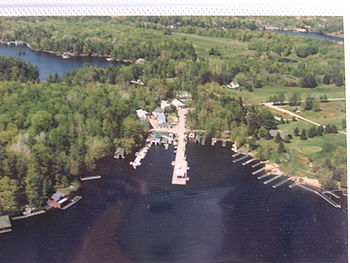
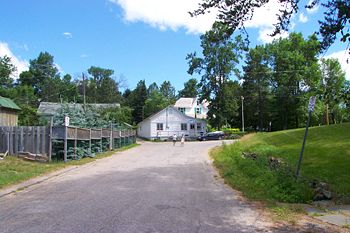
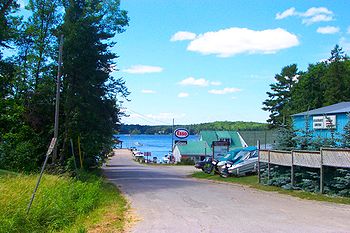
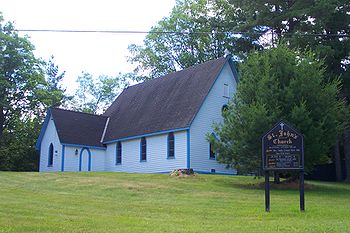
Ontario
Ontario is a province of Canada, located in east-central Canada. It is Canada's most populous province and second largest in total area. It is home to the nation's most populous city, Toronto, and the nation's capital, Ottawa....
, Canada, on Lake Muskoka
Lake Muskoka
Lake Muskoka is located between Port Carling and Gravenhurst, Ontario, Canada. The lake is surrounded by many cottages. The lake is primarily in the Township of Muskoka Lakes, with the southeast corner in the Town of Gravenhurst. The Town of Bala, Ontario is located on the southwest shores of the...
which once served as an important transit point during the steamship era on the lake, and once hosted a summer hotel, called the Beaumaris Hotel and a post office (postal code P0B 1B0). The settlement is located on Tondern Island which, though a true island is attached to the mainland by a small bridge at Milford Bay. Currently the settlement sports a government pier, a marina, The Beaumaris Marina, a general store, Willmotts, a church, Saint John's Anglican Church, and a private summer club, the Beaumaris Yacht Club.
Native people
Geography drove history in the Muskoka region. Studded with lakes and abundant with rocks the land offered an abundance of fishing, hunting, and trapping, but was poorly suited to farming. Largely the land of the OjibwaOjibwa
The Ojibwe or Chippewa are among the largest groups of Native Americans–First Nations north of Mexico. They are divided between Canada and the United States. In Canada, they are the third-largest population among First Nations, surpassed only by Cree and Inuit...
people, European inhabitants ignored it while settling the more promising area south of the Severn River. The Ojibwa leader associated with the area was Mesqua Ukie for whom the land was probably named. The tribe lived south of the region, near present day Orillia and used Muskoka as their hunting grounds. Another Ojibwa tribe lived in the area of Port Carling which was called Obajewanung. The tribe moved to Parry Sound
Parry Sound, Ontario
Parry Sound is a town in Central Ontario, Canada, located on Parry Sound on the eastern shore of Georgian Bay. Parry Sound is located south of Sudbury and north of Toronto. It is the seat of Parry Sound District, a popular cottage country region for Southern Ontario residents. It is also the...
around 1866.
European arrival
Largely unsettled until the late 1760s the European presence in the region was largely limited to seasonal fur trapping, but no significant trading settlements were established. Canadian government interest increased following the American RevolutionAmerican Revolution
The American Revolution was the political upheaval during the last half of the 18th century in which thirteen colonies in North America joined together to break free from the British Empire, combining to become the United States of America...
when, fearing invasion from its new neighbor to the south the government began exploring the region in hopes of finding travel lanes between Lake Ontario
Lake Ontario
Lake Ontario is one of the five Great Lakes of North America. It is bounded on the north and southwest by the Canadian province of Ontario, and on the south by the American state of New York. Ontario, Canada's most populous province, was named for the lake. In the Wyandot language, ontarío means...
and Georgian Bay
Georgian Bay
Georgian Bay is a large bay of Lake Huron, located entirely within Ontario, Canada...
In 1826 Lieutenant Henry Briscoe became the first white man known to have crossed the middle of Muskoka. David Thompson
David Thompson (explorer)
David Thompson was an English-Canadian fur trader, surveyor, and map-maker, known to some native peoples as "Koo-Koo-Sint" or "the Stargazer"...
drew the first maps of the area in 1837 and possibly camped near present day Beaumaris.
Canada experienced heavy European immigration in the mid-19th century, especially from Ireland which experienced famine in the 1840s. As the land south of the Severn was settled, the government planned to open the Muskoka region further north to settlement. Logging licenses were issued in 1866 which opened Monck Township to logging. The lumber industry expanded rapidly denuding huge tracts of the area, but also prompting the development of road and water transportation. The railroad pushed north to support the industry, reaching Gravenhurst
Gravenhurst, Ontario
Gravenhurst is a town in the Muskoka Region of Ontario, Canada. It is located approximately south of Bracebridge, Ontario. The mayor is Paisley Donaldson...
in 1875 and Bracebridge
Bracebridge, Ontario
Bracebridge is a town and the seat of the Muskoka District Municipality of Ontario, Canada.The town was built around a waterfall on the Muskoka River in the centre of town, and is known for its other nearby waterfalls . It was first incorporated in 1875...
in 1885. Road transportation took the form of the Muskoka Colonization Road, begun in 1858 and reaching Bracebridge in 1861. The road was roughly hewn from the woods and was of corduroy
Corduroy road
A corduroy road or log road is a type of road made by placing sand-covered logs perpendicular to the direction of the road over a low or swampy area....
construction, meaning logs were placed perpendicular to the route of travel to keep carriages from sinking in the mud and swamps. Needless to say this made for extremely rugged travel. The lumbering industry spawned a number of ancillary developments, including as mentioned, transport, but also settlements began springing up to supply the workers and Bracebridge, (formerly North Falls) saw some leather tanning businesses develop. Tanners used the bark from lumber to tan hides thereby using what otherwise would be a waste product.
Purchase of Tondern Island
The passages of the Free Grants and Homestead Act of 1868 brought opened the era of widespread settlement to Muskoka. This was the year an Irish immigrant from EnniskillenEnniskillen
Enniskillen is a town in County Fermanagh, Northern Ireland. It is located almost exactly in the centre of the county between the Upper and Lower sections of Lough Erne. It had a population of 13,599 in the 2001 Census...
named Paul Dane purchased Tondern Island for $101 from the crown. The island comprises 338 acres (1.4 km²) and is the home of present day Beaumaris. Dane named the island after the Battle of Tondern between the Prussians
Kingdom of Prussia
The Kingdom of Prussia was a German kingdom from 1701 to 1918. Until the defeat of Germany in World War I, it comprised almost two-thirds of the area of the German Empire...
and Denmark
Denmark
Denmark is a Scandinavian country in Northern Europe. The countries of Denmark and Greenland, as well as the Faroe Islands, constitute the Kingdom of Denmark . It is the southernmost of the Nordic countries, southwest of Sweden and south of Norway, and bordered to the south by Germany. Denmark...
. Ownership of the island passed to Dane's nephew Maurice John McCarthy when Dane died in 1871. The only structure on the island at that time was a log house known as the "big white house" on the site of the future Beaumaris Hotel (now the Beaumaris Golf Club).
Founding of Beaumaris
In 1873 McCarthy sold the island to Edward Prowse and John Harry Willmott for $1,560. The two divided the island in half with Willmott taking the northern and Prowse the southern half. The new owners named the settlement Beaumaris after the resort in AngleseyAnglesey
Anglesey , also known by its Welsh name Ynys Môn , is an island and, as Isle of Anglesey, a county off the north west coast of Wales...
, Wales where they had vacationed. Prowse settled in the big white house while Willmott built a log house next to the site of the present day Willmott store. They cleared part of the land for pasture, built a dock for the newly arrived steamships and connected the island to the mainland by a small log bridge.
As word of the excellent fishing, natural beauty, and an air completely free of ragweed
Ragweed
Ragweeds are flowering plants in the genus Ambrosia in the sunflower family Asteraceae. Common names include bitterweeds and bloodweeds....
providing relief for hay fever
Hay Fever
Hay Fever is a comic play written by Noël Coward in 1924 and first produced in 1925 with Marie Tempest as the first Judith Bliss. Laura Hope Crews played the role in New York...
sufferers spread, tourists came to the area. Willmott responded by building a general store in Beaumaris selling everything from foodstuffs to construction materials. Early tourists built camps around the lake, but were joined by others desiring better accommodations. The first wilderness hotel was built at the head of Lake Rosseau
Lake Rosseau
Lake Rosseau is located in Ontario about 200 kilometers north of Toronto. The lake is surrounded by many cottages, some dating back to the late 19th century. The south end of the lake is in the Township of Muskoka Lakes, and the north end is in Seguin Township. Lake Rosseau is connected to Lake...
in 1870, called Rosseau House. It was owned by New Yorker W.H. Pratt. Prowse saw success with his hotel due to Beaumaris' central location, approximately halfway between Bracebridge and Port Carling and the fine pier he had constructed near the hotel. Trains regularly made the run from Toronto to Gravenhurst where travelers and their luggage were transferred to the great steamers of the Muskoka Navigation Co such as the Sagamo. Making regular stops up the lakes, including Bracebridge, Beaumaris, and Port Carling, tourists there could transfer to smaller ships such as the Islander which could reach into smaller ports. Beaumaris became an important transfer point which brought business to the hotel and store. As the area developed it began to lose some of the wilderness qualities which initially led some of the early groups of campers to establish fishing camps in Beaumaris; Solid Comfort Camp and the Sharon Social Fishing Club. The Sharon Social Fishing Club was founded in 1891 by individuals living in Sharon, Pennsylvania, U.S.A. It is still in existence. Members of the Solid Comfort Camp departed for a more rustic site on the French River. Meanwhile Willmott and Prowse mapped out lots which they intended to sell to vacationers seeking more permanent residence than the hotel.
Beaumaris Hotel
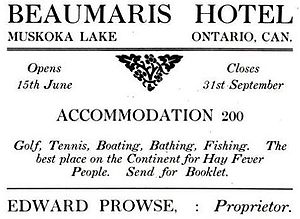
Beaumaris Golf and Yacht Clubs
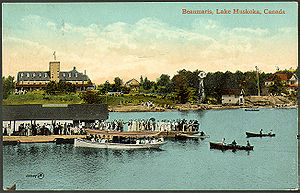
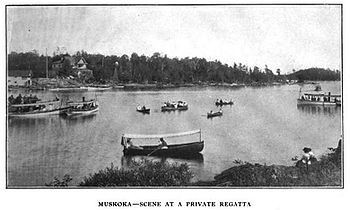
The coming of the car
World War I caused a significant dip in the tourist activity for the area and hence the economy. After the war, however, significant advances in the automobile brought demand for improved (paved) roads. These two developments, motorboats and private cars brought greater overall development of the area and spread development out over the lakes. Freed from the ports of call of the steamships, people built cottages farther afield. Demand began dropping for the steamship lines. World War II caused another decline as wartime shortages kept many Americans at home and many Canadians were engaged in war activities. Postwar prosperity brought another boom based around the automobile and the newly affordable fiberglassFiberglass
Glass fiber is a material consisting of numerous extremely fine fibers of glass.Glassmakers throughout history have experimented with glass fibers, but mass manufacture of glass fiber was only made possible with the invention of finer machine tooling...
boat. Suddenly owning a summer cottage became possible not only for the adventurous or the wealthy, but for many in the middle class. The steamship companies retired their boats one by one until the last sailing in the late 1950s. The end of the old era for Beaumaris came on 21 July 1945 when, from a small fire in the kitchen, the Beaumaris Hotel was engulfed in flames and burned to the ground. Edward John Van Buren, an employee of the hotel, pleaded guilty to arson and was sentenced to 2 years for the crime. The land under the hotel was eventually purchased by the Beaumaris Land Company which also owned the physical property for the golf and yacht clubs. After several attempts to attract a new hotel to the site, it was eventually turned over to the new golf clubhouse.
Notable residents
Through the years Beaumaris has hosted a number of notable seasonal residents and cottagers including:- James Francis Burke US Congressman
- Thomas Mellon II Son of the founder of Mellon Bank
- Benjamin G Wells Publisher of The Philadelphia Press
- Samuel M Willock President of the Waverly Oil Company
- Wilson Miller President of the Pittsburgh Locomotive Works
- James H Brown US Congressman, President of Colonial Steel Company
- Rubin Miller President of the Crescent Steel Company and President of the Bank of Pittsburgh
- William Witherow President of the Blawnox Steel Corporation
- William Larimer MellonWilliam Larimer MellonWilliam Larimer Mellon, Sr. , sometimes referred to as W. L., was a founder of Gulf Oil.-Biography:Born in Pittsburgh, Pennsylvania on June 1, 1868 to James Ross Mellon, eldest son of Judge Thomas Mellon, and Rachel Larimer Mellon, daughter of railroad and land baron William Larimer, Jr...
Founder of Gulf Oil - James McKayJames McKay (industrialist)James McKay was a 19th century industrialist in Pittsburgh, Pennsylvania. The founder and owner of the James McKay Company of Pittsburgh, a manufacturer of metal chains, he was also active in oil and gas development with one of the earliest producing properties in Pennsylvania...
President of James McKay Company

